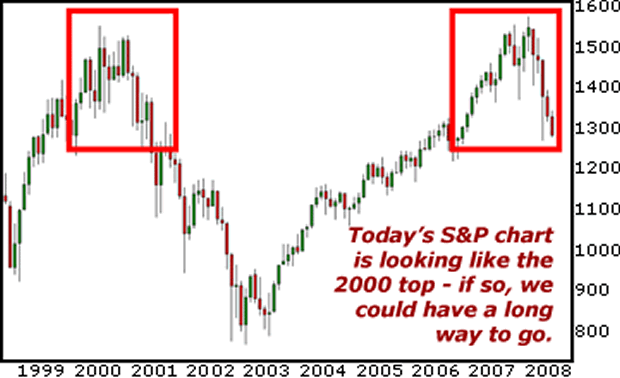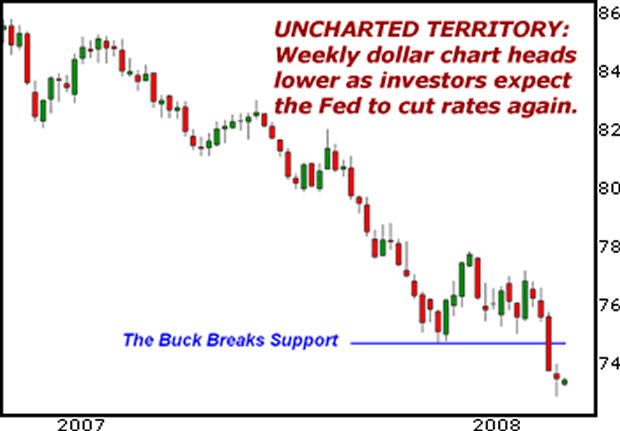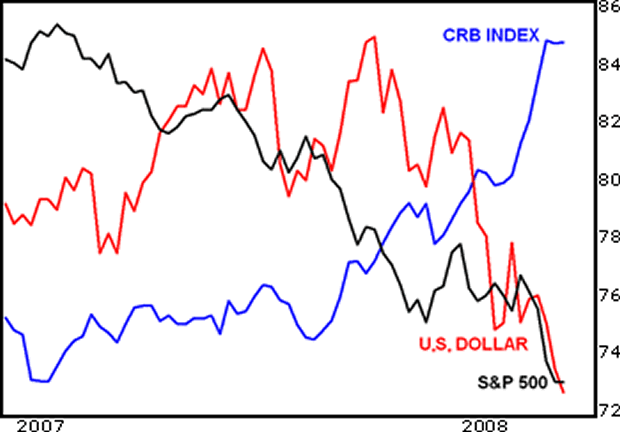How to Beat the Stock, US Dollar and Credit Market Bears
Stock-Markets / Stocks Bear Market Mar 12, 2008 - 04:49 PM GMT The recent action on Wall Street is enough to send shivers up the spine of even the biggest bull. Despite yesterday's Fed-induced rally, we have multiple bear markets closing in simultaneously, with everything from stocks to the U.S. dollar to the credit markets getting clawed to pieces.
The recent action on Wall Street is enough to send shivers up the spine of even the biggest bull. Despite yesterday's Fed-induced rally, we have multiple bear markets closing in simultaneously, with everything from stocks to the U.S. dollar to the credit markets getting clawed to pieces.
But there is one sector that is still in a raging bull market — commodities. And the bearish action in the other markets could actually pump up commodities even more.
 More on that in a moment. First, let's look at three bear markets and how low they could go ...
More on that in a moment. First, let's look at three bear markets and how low they could go ...
Bear Market #1: Stocks — Bearish Feeding Pattern
The stock market is facing multiple problems including a slowing economy, housing bubble implosion, credit crisis infection and deteriorating earnings for many sectors.
Let's take a closer look at corporate earnings, the engine that drives Wall Street. Earnings per share for the S&P 500 declined 4.2% in 2007. This happened despite the fact that most analysts had a positive outlook for the year at the end of 2006.

Many analysts expect earnings for the S&P 500 to recover in the second half of 2008. You can see how much investors trust this outlook by the S&P 500's chart action. Look at the right side of this monthly chart ...
You can see how the S&P 500's sell-off right now looks very similar to the one in 2000-2001 and 2007-2008 (so far). Both patterns show a choppy top followed by an extended sell-off.
Why is this important? Well, chart patterns often repeat themselves because investors tend to repeat their mistakes.
That means if the S&P 500 does repeat history, it could go as much as another 40% to the downside!
Now, not all sectors are performing the same. Financials are getting pummeled mercilessly while the energy sector looks like it's still in a bull market. But there's plenty to indicate the broad market could go lower in a sell-off that could last a long time.
Bear Market #2: The U.S. Dollar — Uncharted Territory
Heck, even cash isn't safe anymore. The U.S. dollar index, which compares the greenback to the world's major currencies, has fallen about 15% this year and is near its lowest levels ever. Recession fears are driving the dollar lower, as jobs disappear, home prices fall and consumer confidence plummets.

nd the Federal Reserve isn't helping out. The market is betting the Fed will lower interest rates by 50 to 75 basis points at its meeting next week. That lowers the yield on the dollar versus other currencies, helping grease the skids to send it even lower.
In short, even if you put all your money in cash, and then put that cash under your mattress, you'll still lose money.
Bear Market #3: Credit Markets — The Worst in Decades
Mike Larson is probably one of the best brains concentrating on the credit markets. So I took him seriously when he emailed me on Monday to say:
"We aren't 'entering' a bear market for credit. We're already embroiled in a world-class credit market 'perfect storm' the likes of which we haven't seen in decades."
First we had a subprime mortgage crisis that was supposed to be "contained," only it went on to infect the rest of the credit markets ...
Next, asset-backed commercial paper was sent through the shredder ...
The municipal bond market was rocked by bond auction failures ...
Then Fannie Mae and Freddie Mac — the mortgage loan giants supposedly backed up by an implied guarantee from the Federal government — ran into trouble.
And at the end of last week, JPMorgan Chase described what's happening as a "systemic margin call," in which the whole financial system is facing demands to come up with cash it doesn't have.
So What Works? Hard Assets!
I wouldn't touch any of the three markets I've just described with a 10-foot pole. But I do like hard assets — commodities — and select commodity stocks.
Just look at this chart of the CRB Index — which tracks a basket of commodities — as compared to both the U.S. dollar and the S&P 500 over the past year.

As you can see, the CRB has soared while stocks and cash have plunged.
Heck, commodities are experiencing the biggest boom of our lifetimes. In 2007 alone, we saw gold prices jump 36.6% ... crude oil prices explode 70.8% ... and agriculture prices — corn, wheat, soybeans and more — soar to new records! And this year, the red-hot rally continues.
Here are just some of the underlying forces driving commodities ...
OIL — China, the second-biggest oil-consuming country, increased crude-oil imports by 18% last month and halted overseas shipments to meet rising demand. What's more, Goldman Sachs just came out and said that $200-per-barrel oil may be the harsh reality in the not-too-distant future.
GOLD — There is a widening gap between supply and demand. Global gold production fell to a 10-year low of 2,444 metric tonnes in 2007, according to Gold Fields Mineral Service. This year production will likely drop again. Meanwhile investment demand from exchange traded funds is growing at a rapid clip.
AGRICULTURE — The USDA dropped a bombshell recently — reporting that U.S. wheat stockpiles may fall to the lowest level in 59 years! As disturbing as that is, it is 100% bullish for grain prices, especially given soaring worldwide demand for agricultural products.
In fact, a recent study by AIG, the world's largest insurer, showed that agriculture investments linked to commodity indexes may climb by $10 billion in 2008. That's TWICE the rise in investment we saw in 2007.
How You Can Get A Piece of the Action
It used to be that the only way to play the raging bull market in commodities was to either buy the stocks of miners and other producers, or take the big leap into commodity futures, where the risks multiply exponentially along with the rewards.
But now there is another way that also offers the opportunities for truly stellar returns ... a golden harvest of potential profits in wheat, oil, gold, copper and more.
I'm talking about commodity exchange traded funds (ETFs) and exchange traded notes (ETNs).
A good example would be the Dow Jones/AIG Commodity Index iPath Note (DJP). This ETN is essentially a debt agreement that links the value of the note to an index of commodities. Both ETFs and ETNs give investors a way to participate directly in commodity price moves at relatively low cost with more safety.
Be sure to do your own due diligence before you buy commodity-based ETFs. But if these kind of investments fit your goals, I think now's a great time to start investigating them. After all, as stocks slide further down a slippery slope ... as the value of the U.S. dollar deteriorates ... and as investors find no safe haven in bonds ... commodities start to look better and better.
Yours for trading profits,
Sean
P.S. Interested in knowing what my favorite commodity ETFs are right now? Then heads up — I'm issuing new recommendations in my just-launched Red-Hot Commodity ETF service TODAY! Click here for the scoop.
This investment news is brought to you by Money and Markets . Money and Markets is a free daily investment newsletter from Martin D. Weiss and Weiss Research analysts offering the latest investing news and financial insights for the stock market, including tips and advice on investing in gold, energy and oil. Dr. Weiss is a leader in the fields of investing, interest rates, financial safety and economic forecasting. To view archives or subscribe, visit http://www.moneyandmarkets.com .
Money and Markets Archive |
© 2005-2022 http://www.MarketOracle.co.uk - The Market Oracle is a FREE Daily Financial Markets Analysis & Forecasting online publication.



